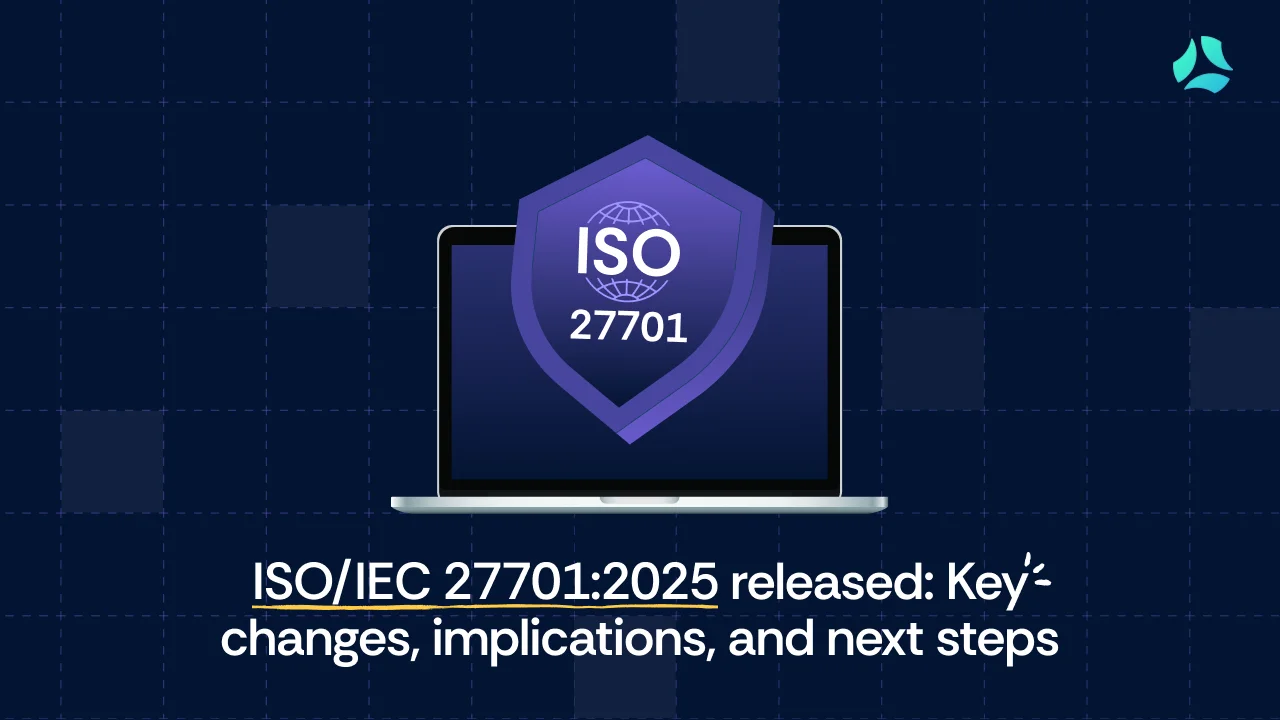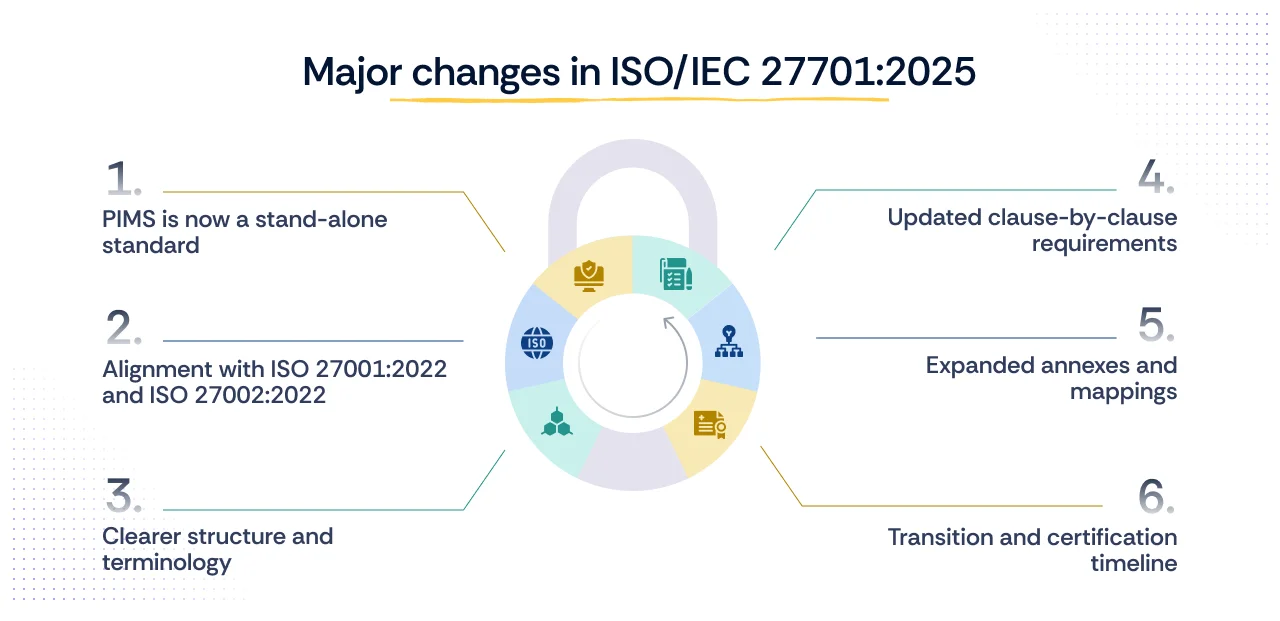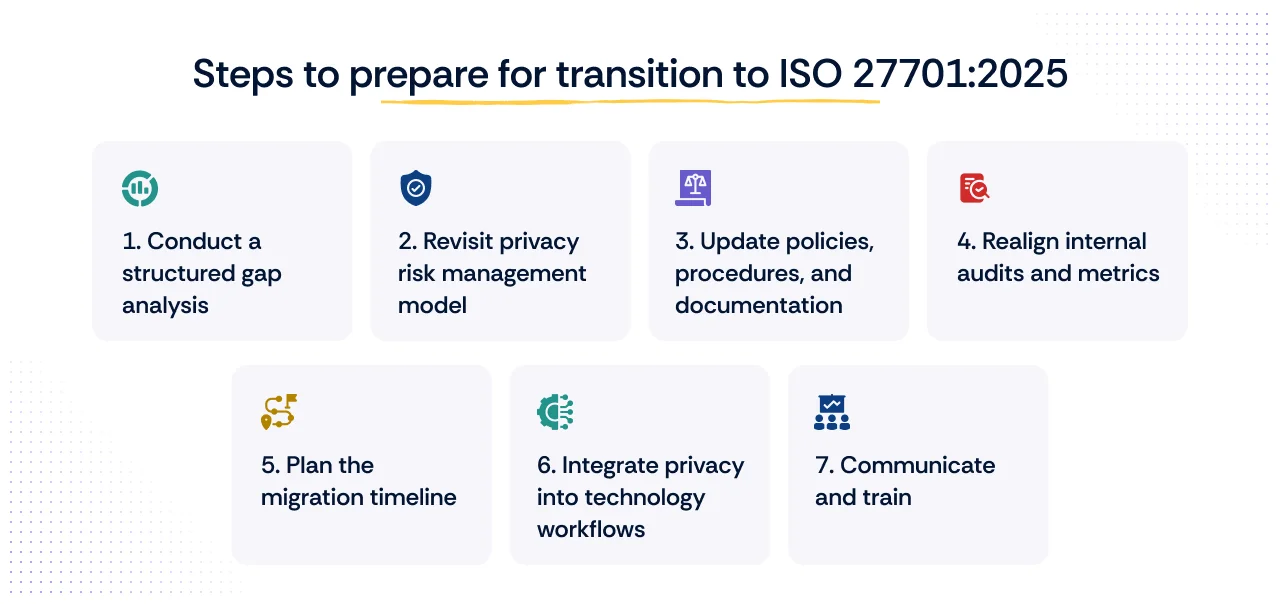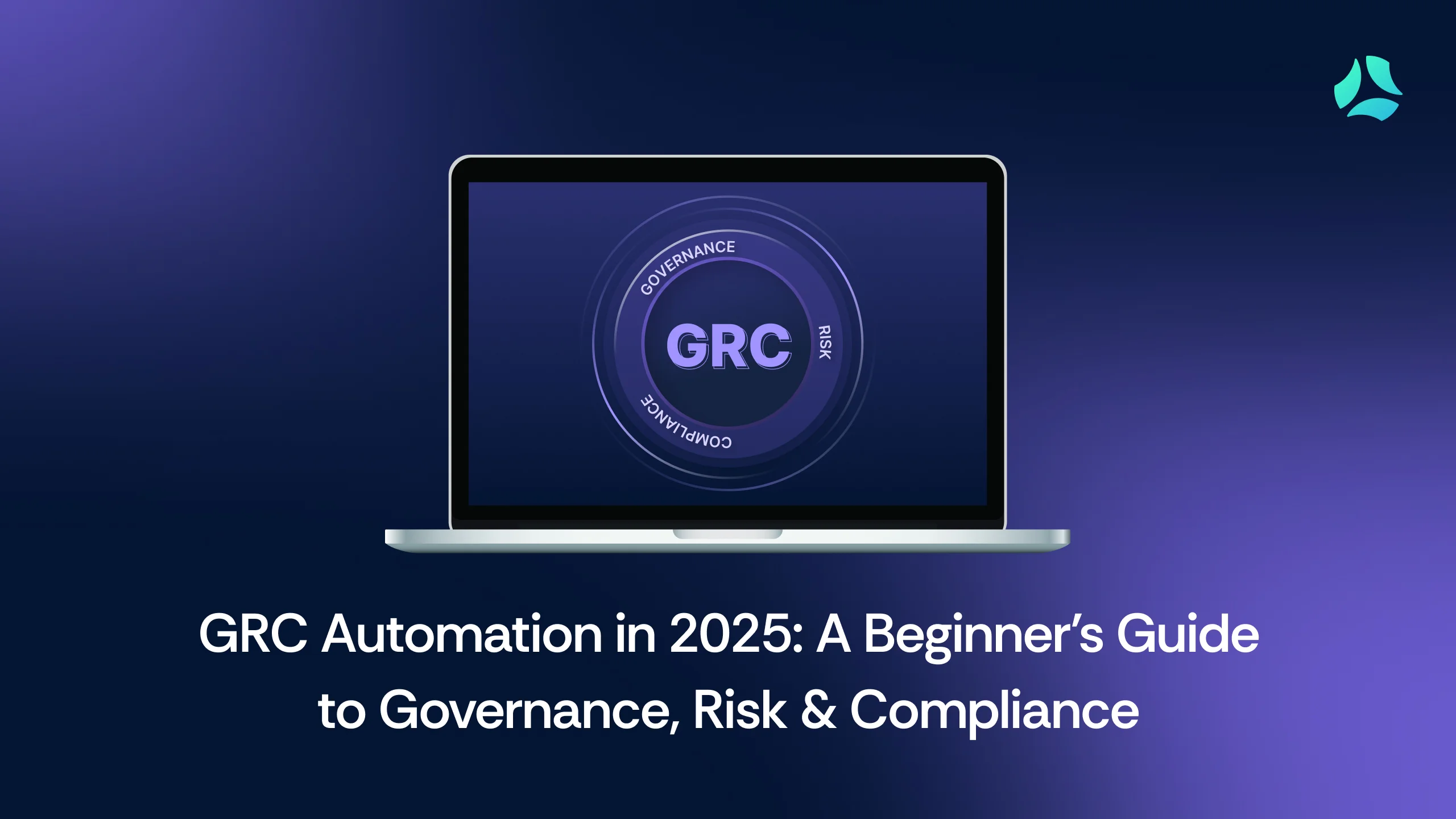What’s new in ISO/IEC 27701:2025: A closer look at the updated PIMS standard

The updated version of ISO/IEC 27701, the Privacy Information Management System (PIMS) standard, has officially been released as ISO/IEC 27701:2025. This revision builds on the foundation set by the 2019 edition and introduces key updates that make the framework more adaptable and aligned with current ISO standards.
Originally developed as an extension to ISO/IEC 27001 and ISO/IEC 27002, ISO/IEC 27701 helps organizations establish and maintain systems for managing personal data in compliance with global privacy principles. The 2025 update strengthens this purpose by refining its structure, clarifying terminology, and offering greater flexibility for organizations implementing privacy controls.
In this blog, you’ll find a breakdown of what’s new in ISO/IEC 27701:2025, why the update matters, and what steps you can take to align your privacy program with the new requirements.
What’s changed in ISO/IEC 27701:2025

The 2025 revision of ISO/IEC 27701 has now been officially released, marking a major milestone in global privacy management. This updated edition replaces the 2019 version and introduces structural and conceptual refinements that make the PIMS framework clearer, more flexible, and easier to integrate across different organization types.
Below is a breakdown of the most important changes introduced in ISO/IEC 27701:2025.
1. PIMS is now a stand-alone standard
The most significant change is that ISO/IEC 27701:2025 is no longer an extension of ISO/IEC 27001 and ISO/IEC 27002. It is now a stand-alone standard, capable of being implemented independently of an Information Security Management System (ISMS).
This means that organizations can now pursue PIMS certification even if they do not hold ISO/IEC 27001 certification. For many privacy-driven entities, including those that do not manage complex information security frameworks, this lowers the barrier to entry and allows them to demonstrate privacy accountability in a globally recognized way.
2. Alignment with ISO/IEC 27001:2022 and ISO/IEC 27002:2022
While ISO/IEC 27701:2025 is stand-alone, it remains fully aligned with ISO/IEC 27001:2022 and ISO/IEC 27002:2022. The control language, structure, and terminology have been updated to reflect the latest revisions in those standards.
This alignment ensures consistency across management systems, particularly for organizations maintaining both an ISMS and a PIMS, and supports unified governance across security and privacy programs. It also harmonizes the framework with ISO/IEC 29100 (Privacy Framework), ISO/IEC 27018 (Protection of PII in Cloud Services), and ISO/IEC 29151 (Code of Practice for PII Protection).
3. Clearer structure and terminology
The 2025 version introduces a cleaner clause structure and refined terminology to improve readability and implementation clarity. The standard follows the updated Annex SL framework, ensuring uniformity with other ISO management systems.
Key terminology, such as “personal data,” “PII controller,” and “PII processor,” has been standardized to align with international privacy norms. The distinction between requirements (“shall”) and guidance (“should” or “may”) is now more explicit, minimizing interpretation issues during audits.
4. Updated clause-by-clause requirements
Clauses 4–10 have been refined to ensure better focus and practicality:
- Clause 4 (Context of the organization): Expanded to help organizations define PIMS scope and boundaries based on the nature of personal data processed.
- Clause 5 (Leadership): Strengthened to emphasize top management accountability for privacy governance and the integration of privacy objectives into organizational decision-making.
- Clause 6 (Planning): Updated to incorporate risk-based thinking for privacy, including alignment with new risk assessment approaches introduced in ISO/IEC 27001:2022.
- Clause 7 (Support and operation): Clarified roles, responsibilities, and communication requirements for both PII controllers and processors.
- Clause 8 (Operational guidance): Refined to provide specific, actionable steps for implementing privacy controls and managing third-party processing relationships.
- Clause 9 (Performance evaluation): Expanded to include measurable privacy metrics, internal audits, and management review elements tailored for privacy performance.
- Clause 10 (Improvement): Reinforces continual improvement through corrective actions, privacy incident reviews, and lessons learned from audits or breaches.
5. Expanded annexes and mappings
The annexes in ISO/IEC 27701:2025 have been reorganized and expanded for clarity. They now include updated mappings to ISO/IEC 27001:2022 controls and guidance on applying the standard in cloud, cross-border, and regulatory contexts.
The GDPR mapping annex, in particular, has been revised to better illustrate how ISO/IEC 27701:2025 can serve as a certification framework for demonstrating compliance with global privacy laws.
6. Transition and certification timeline
The standard was officially released on 14 October 2025, and transition rules are expected to be published shortly by ISO and accredited certification bodies. Organizations certified under ISO/IEC 27701:2019 will be granted a transition period (typically between 24 and 36 months) to migrate to the 2025 version.
New applicants can now pursue certification directly against ISO/IEC 27701:2025.
Why these changes matter

The 2025 revision of ISO/IEC 27701 is more than a routine update; it represents a fundamental shift in how privacy governance can be demonstrated, audited, and maintained. For leaders responsible for safeguarding personal data, these changes open new opportunities and set clearer expectations for what mature privacy management should look like.
1. A path to certification without ISO/IEC 27001
In its previous form, ISO/IEC 27701 was limited to organizations that already operated an Information Security Management System under ISO/IEC 27001. The 2025 update removes that restriction.
Now, any organization, even one that does not have a certified ISMS, can implement and certify a Privacy Information Management System.
This change is especially significant for:
- Data-driven businesses that handle large volumes of personal information but do not need full ISO 27001 certification.
- SMBs and SaaS companies that want to demonstrate privacy accountability without duplicating information security work.
- Public-sector and nonprofit entities where privacy protection is critical, but resources for comprehensive security programs are limited.
The stand-alone nature of ISO/IEC 27701:2025 makes privacy certification more inclusive and attainable, broadening its global adoption.
2. Stronger alignment with evolving regulations
Privacy laws such as the EU GDPR, CCPA, and upcoming regional frameworks emphasize accountability, demonstrable controls, and documented risk management. The 2025 version of ISO/IEC 27701 is built to support these expectations.
By clarifying how privacy controls map to global regulations, the new edition helps organizations show evidence of compliance in audits, regulatory assessments, and vendor reviews. It also helps avoid duplication between internal privacy programs and external certification frameworks.
3. A clearer and more auditable structure
For auditors and internal teams, the 2019 version sometimes left grey areas between what was required and what was recommended. ISO/IEC 27701:2025 resolves that ambiguity.
Each requirement now uses precise “shall” statements, while guidance is expressed separately as “should” or “may.” This clarity not only streamlines external audits but also reduces interpretation errors during self-assessment and control implementation.
4. Integrated management and leadership accountability
The emphasis on leadership accountability across Clauses 5 and 9 signals ISO’s continued move toward a governance-driven approach. Privacy objectives must now be integrated into organizational planning and performance evaluations, not treated as isolated compliance exercises.
For executives, this means privacy management becomes a board-level responsibility, requiring measurable outcomes, defined KPIs, and periodic management reviews. It strengthens the link between privacy maturity and organizational trust.
5. Consistency across privacy and security frameworks
Although ISO/IEC 27701:2025 can now stand alone, it remains structurally aligned with ISO/IEC 27001:2022. This ensures that organizations managing both security and privacy programs can run them under a unified governance model.
Such consistency simplifies control mapping, reduces documentation overlap, and helps teams use the same monitoring and reporting tools for both domains. In practice, it allows privacy and security functions to operate as complementary parts of a single management system.
6. Readiness for future technological and regulatory shifts
By harmonizing with the updated ISO/IEC 27002:2022 control language and referencing newer privacy frameworks, the 2025 edition positions organizations to adapt to emerging technologies, including AI-driven analytics and cross-border data transfers.
It introduces flexibility that lets privacy controls evolve alongside regulatory requirements, instead of locking organizations into rigid interpretations. In effect, ISO/IEC 27701:2025 becomes a living foundation that can accommodate future privacy risks without requiring another structural overhaul.
How to prepare for the transition

The release of ISO/IEC 27701:2025 doesn’t just introduce new clauses; it resets how organizations approach privacy governance. For CISOs and CTOs, the transition phase is the opportunity to streamline systems, modernize risk management, and align security and privacy under one operating model.
Here’s a step-by-step approach to prepare for the change.
1. Conduct a structured gap analysis
Start by comparing your existing ISO/IEC 27701:2019 implementation (or equivalent privacy framework) against the 2025 edition. Focus on three dimensions:
- Scope: Verify if your current PIMS boundaries still make sense, especially since the new version allows for a standalone certification.
- Controls: Identify where mappings have changed, particularly in Clauses 4–10 and the revised annexes.
- Terminology: Update documentation to reflect standardized definitions and role distinctions (PII controller vs processor).
CISOs should lead this assessment from a governance and audit perspective, while CTOs should involve technical owners to validate control coverage across systems, APIs, and data flows.
2. Revisit your privacy risk management model
The new edition encourages a more integrated, risk-based approach.
- CISOs should merge privacy risk analysis into their enterprise or cyber risk register.
- CTOs should ensure that engineering teams incorporate privacy impact assessments into the software development lifecycle (SDLC).
This integration enables privacy risk to be quantified, tracked, and mitigated alongside other operational and security risks.
3. Update policies, procedures, and documentation
Clause 5 of ISO/IEC 27701:2025 strengthens leadership accountability. Your policies must reflect that shift.
- Refresh your privacy policy, ensuring top management endorsement and measurable objectives.
- Update roles and responsibilities to clearly assign ownership for privacy KPIs, internal audits, and breach management.
- Review vendor management procedures, as processor and controller obligations are now more sharply defined.
For CTOs, this is also the time to document how technical controls, including encryption, access management, and data minimization, link directly to the PIMS framework.
4. Realign internal audits and metrics
Clause 9 emphasizes measurable performance indicators and internal evaluations.
- CISOs should define quantitative metrics (e.g., number of privacy incidents, audit findings closed, training completion rates).
- CTOs should automate evidence collection wherever possible, linking logs, configurations, and system reports directly to privacy objectives.
The goal is to make privacy performance as measurable and auditable as security performance.
5. Plan the migration timeline
ISO and certification bodies are expected to establish a formal transition window, likely between 24 and 36 months.
During this period:
- Organizations already certified to ISO/IEC 27701:2019 can continue their certification, but should prepare for migration audits.
- New applicants can certify directly under the 2025 version.
CISOs should coordinate with certification partners early to align audit cycles. CTOs should ensure that system configurations, access logs, and privacy control evidence are audit-ready under the new structure.
6. Integrate privacy into technology workflows
The revised standard provides room for privacy-by-design and privacy-by-default practices.
- Embed privacy assessments into DevSecOps pipelines.
- Automate data retention, deletion, and consent tracking.
- Implement change management triggers for privacy impact review whenever new systems or data flows are introduced.
This is where technology and compliance intersect; privacy management becomes part of the build process, not a post-launch checklist.
7. Communicate and train
Finally, make sure everyone understands what’s changing.
- Conduct targeted workshops for engineers, product managers, and legal teams.
- Update onboarding modules to reflect the new PIMS structure and roles.
- Communicate the transition plan to external stakeholders, especially regulators, customers, and partners who rely on your certification.
For CISOs and CTOs, this step is critical to turning a compliance update into an organization-wide culture shift.
How Scrut helps you implement and maintain PIMS
Scrut simplifies your journey to ISO/IEC 27701:2025 compliance by turning privacy management into an automated, auditable, and continuous process. With 1400+ pre-mapped controls across frameworks and 100+ integrations, Scrut automatically gathers evidence from your cloud, HR, and identity systems, reducing manual work for CISOs and CTOs alike.
Its policy management module, backed by 75+ expert-vetted templates, helps you establish and maintain the documentation ISO/IEC 27701:2025 requires. Daily automated checks monitor privacy configurations and vendor risks, while Trust Vault lets you share live proof of compliance with auditors and customers. By managing privacy, security, and risk programs on a single platform, Scrut gives you a unified, always-current Privacy Information Management System, one that works in real time, not just at audit time.
Ready to build a privacy program that never falls behind?
Get started with Scrut today to implement, monitor, and certify your Privacy Information Management System effortlessly. Automate your ISO/IEC 27701:2025 compliance, gain real-time visibility, and turn privacy assurance into your competitive edge.

FAQs
1. What is ISO/IEC 27701:2025?
ISO/IEC 27701:2025 is the updated international standard that defines the requirements for establishing, implementing, maintaining, and continually improving a Privacy Information Management System (PIMS). It replaces the 2019 version and serves as the global benchmark for how organizations should manage personal data responsibly.
2. When was ISO/IEC 27701:2025 released?
The new edition of ISO/IEC 27701 was officially released on 14 October 2025. It is now available for purchase through the ISO website and accredited standards distributors.
3. Does my organization need ISO/IEC 27001 to get certified for ISO/IEC 27701:2025?
No. Unlike the 2019 version, ISO/IEC 27701:2025 can now be implemented and certified independently. Organizations without an existing ISMS (Information Security Management System) can still pursue PIMS certification. However, aligning both standards remains best practice for organizations handling sensitive or large-scale data processing.
4. Who should consider implementing ISO/IEC 27701:2025?
The standard is suitable for any organization — public or private, large or small — that processes personal data. It is particularly relevant for:
- SaaS and technology companies handling customer or user data.
- Healthcare, finance, and education sectors subject to privacy regulations.
- Cloud service providers and data processors managing third-party information.


















